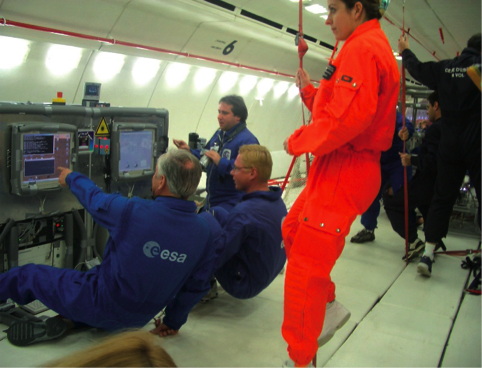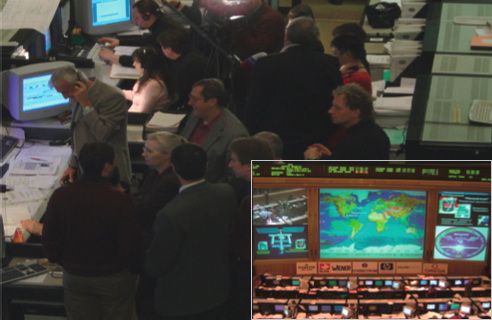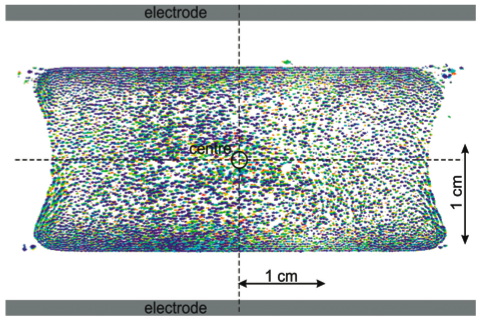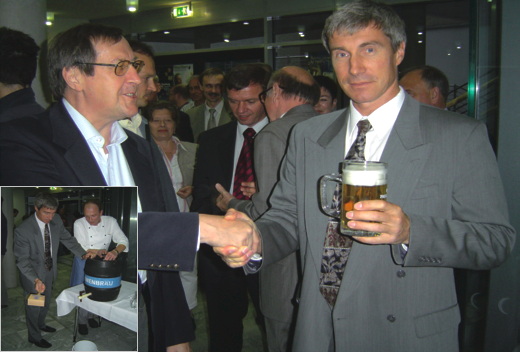Theory Group
Annual Report 2006
Experiments and Projects3.4 Complex Plasmas
Complex plasma research is a fast growing field covering fundamental physics with applications in many other fields, e.g. solid state physics or fluid physics. The reason for the latter is that in complex plasmas phenomena like melting can be investigated on the most fundamental, i.e. the kinetic level. This is due to the fact that the crystal or fluid is formed by particles of micrometer size in distances of millimeters in a classical manner by electrostatic interaction. The so-called microparticles can be illuminated by a laser beam and the scattering can be easily observed with CCD cameras allowing us to follow the particles over long time in high precision. This allows us to use the complex plasma as a model system for crystals and fluids. Beside this, the microparticles' charge fluctuations and cannibalism, so-called Non-Hamiltonian effects, add new physics which makes complex plasmas interesting to investigate on their own.
The coverage of a broad phase space of complex plasmas makes it necessary to investigate in different setups, each with different and special features. Therefore we installed many laboratories over the last 9 years, since the experimental group has been established at MPE. Especially during the 5 years of our cooperation with the MPI for Plasma Physics (IPP) within CIPS (Centre for Interdisciplinary Plasma Science), specially funded by the Max Planck Society, new labs could be founded, like the Strong Magnet Lab, a 4 Tesla setup allowing for the first time to investigate the complex plasma in a strongly coupled strongly magnetised regime, or the PAGE lab, a PArticle Growth Experiment with the intention to grow diamond particles of very high quality (this is a cooperation with IPP). CIPS could be continued on a smaller scale by the research group ''Experimental Complex Plasmas''. Other labs were partly funded by DLR, like the Adaptive Electrode and the Cryo lab, and of course, the science labs for the microgravity experiments PK-3 Plus and PK-4.

Fig. 1: PK-4 parabolic flight measurements in Bordeaux during a period of micro-gravity. (Courtesy of M. Kretschmer)
Microgravity research is a mandatory part of the research of complex plasmas. Microparticles are about 109 times heavier than atoms with sizes like dust particles and gravity plays an important role leading to stress and inhomogeneity of the system. Therefore we started the investigation of complex plasmas under microgravity conditions already quite early in the history of this new research, strictly speaking the idea of the crystallisation of complex plasmas without gravity was the starting point at the Institute. In 1996 the era of research under microgravity started with parabolic flights, followed by two sounding rocket experiments. Since 2001 our Institute has a permanent laboratory on the International Space Station ISS. The latter is a cooperation with the Russian Academy Institute for High Energy Densities in Moscow. PKE-Nefedov was the first long term experiment on complex plasmas on the ISS operational over more than 4 1/2 years. Since January 2006 the follow-up laboratory PK-3 Plus is operational (see selected article).
Even the future laboratory PK-4 is in the pipeline; a Phase A/B study financed by ESA started in the beginning of the year. PK-4, compared to its precursors, will be a fully new developed apparatus. Its main goal is the investigation of the fluid behaviour of complex plasmas, like the transition from laminar to turbulent flow or the supercritical fluid and the critical point. The project is based on laboratory developments since 2002 and parabolic flights. The breadboard assembly was flown on parabolic flights in October in Bordeaux. The main goal of this short time microgravity experiments (each of the 93 parabolas provides about 20 sec low-g) was to test technical achievements on its microgravity relevance. Beside the pure technical reason some interesting scientific results could be obtained.
PK-3 Plus - Complex Plasma on the ISS
The operational phase of our Plasma Crystal Laboratory PK-3 Plus on the International Space Station ISS started in 2006 successfully. PK-3 Plus was mainly built at MPE with assistance from the German Space industry Kayser-Threde and financed by German Space Agency (DLR). The PK-programme is a joint cooperation between our Institute and the Russian Academy Institute for High Energy Densities in Moscow. This partnership provides the free access of accommodation and resources on the ISS.
The International Space Station ISS is a perfect platform for research under microgravity conditions. MPE together with its Russian partner Institute IHED makes use of this special opportunity since right from the beginning of the colonisation of our outpost in Space in 2001. PKE-Nefedov, the first long-term natural science laboratory on the ISS was operational over more than 4 years with a scientific yield of more than 30 refereed publications. While performing experiments and gaining more and more know-how we designed and fabricated an advanced follow-up laboratory. This so-called PK-3 Plus laboratory was launched in December 2005 by a Progress rocket from Baikonur. Since January 2006 it is operational and has been used four times for experiments during the reporting period.
PK-3 Plus' special features allow the detailed investigation of complex plasmas under microgravity conditions. Compared to the precursor experiment PKE-Nefedov the system provides a much better homogeneity and symmetry of the complex plasma and highly advanced diagnostics. This is mandatory for many detailed experiments, like the formation and investigation of plasma crystals.

Fig. 1: Scientists follow the first experiment on the ISS performed by cosmonaut Valerie Tokarev in January 2006 from the control centre in Korolov (see also insert).

Fig. 2: Homogeneous distribution of a complex plasma under microgravity conditions, one of the main achievements of PK-3 Plus. This allows many interesting investigations in the crystalline and fluid phase.
The first experimental mission has been performed by cosmonaut Valery Tokarev from 10th to 16th January. After the assembly, which has to be done before every experimental mission since the accommodation place is always temporarily, the three experiments have been conducted on the 12th, 13th and 16th. Already the first live video that was transferred to ground during the experiments showed the advanced features, mentioned above, of PK-3 Plus, especially concerning homogeneity and iso-tropy of the complex plasma. Fig. 2 shows this from a dynamic point of view. The group of scientists, engineers and officials from Russian and German side followed these experiments keenly and enthusiasticly in the control centre in Korolov near Moscow (Fig. 1). The scientists received the experimental data after their transport with Sojus back to Earth in the cosmonauts hand luggage in April, right in time for the planning of the next set of experiments in August.
In August we performed a double mission with a total of six experiments on consecutive days. The crew time was split between cosmonaut Pavel Vinogradov and the German ESA astronaut Thomas Reiter. For Thomas Reiter's Astrolab Mission we opened the project for ESA scientists on a cooperation basis. This, in principle, pure Russian-German laboratory gained from this commitment, since new topics for the research of complex plasmas could be defined and additional experiments could be performed. Especially the research or search for the critical point in the gas-liquid phase transition of complex plasmas is one of the hot topics here. Vinogradov and Reiter performed, beside practically automatic running experiments, each one manual experiment, where the astronaut/cosmonaut had to control the apparatus as a real experimenter. This requested special training of the astronaut. The scientists on ground in the control centre were following these experiments and were permanently informed by the cosmonaut/astronaut via an audio connection to the ISS.
Thomas Reiter also performed a second series of experiments in October. These were again ESA funded experiments. Additionally, Thomas Reiter gave a lecture from the ISS about the PK-3 Plus lab and science in front of a group of students taking part in the EuMAS Masters Programme in Aeronautics and Space technology. The students from the Technical University in Munich were listening in the Columbus Control Centre in Oberpfaffenhofen near Munich, others from the partnering Universities via the internet. Prof. G. Morfill was the second lecturer on ground.
Russian cosmonauts and heroes Yuri Baturin, Yuri Gidzenko, Sergey Krikalev and Valerie Tokarev joined the first scientific PK-3 Plus symposium held at the MPE in the beginning of October. Additionally, we invited a large delegation from our Russian partners, including scientist, engineers from RKK-Energia and officials from the Cosmonaut training centre. As a start of the symposium the delegation was taken to the Oktoberfest, to teach them old Bavarian tradition. After the celebration, the full delegation met on a Symposium on two consecutive days at our Institute for the discussion of the past, present and future of our research on the ISS. Beside the most recent scientific results from the mission in August, detailed information on implementation of the experiments and background about the hard- and software of the apparatus used on the ISS were given by the attending cosmonauts.
In total, the first year of operation of the PK-3 Plus laboratory on the International Space Station was a great success.

Fig. 3: German ESA Astronaut Thomas Reiter on board of the ISS with the PK-3 Plus laboratory. The Experiment Container is mounted in the Service Module. (Courtesy of NASA)

Fig. 4: Cosmonaut, Russian hero and world record holder of stay in orbit Sergey Krikalev during his first attempt to open a beer barrel (insert) and with the scientific leader of the PK-3 Plus experiment, Gregor Morfill, during a celebration at the Institute.
Updated: 2007-10-18
Contact: Michael Kretschmer